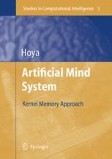Search
Search Results
-
The Artificial Mind System (AMS), Modules, and Their Interactions
The previous two chapters have been devoted to establishing the novel artificial neural network concept, namely the kernel memory concept, for the...
-
On the Classification of Maze Problems
A maze is a grid-like two-dimensional area of any size, usually rectangular. A maze consists of cells. A cell is an elementary maze item, a formally...
-
Genetic Algorithms and Genetic Linkage
This chapter provides a summary of fundamental materials on genetic algorithms. It presents definitions of genetic algorithm terms and briefly...
-
Learning Classifier Systems: A Reinforcement Learning Perspective
Reinforcement learning is defined as the problem of an agent that learns to perform a certain task through trial and error interactions with an...
-
Maximization of Combustion Efficiency: A Data Mining Approach
Maximizing combustion efficiency with minimizing emissions is of importance to electric power industry. In this research, the impact of data...
-
Supporting Deep Learning in an Open-ended Domain
Self-explanation has been used successfully in teaching Mathematics and Physics to facilitate deep learning. We are interested in investigating...
-
Basics of Machine Learning by Support Vector Machines
Here, we talk about the (machine) learning from empirical data (i.e., examples, samples, measurements, records, patterns or observations) by applying...
-
Epilogue – Towards Develo** A Realistic Sense of Artificial Intelligence
So far, we have considered how the artificial mind system based upon the holistic model as depicted in Fig. 5.1 (on page 84) works in terms of the...
-
Memory Modules and the Innate Structure
As the philosopher Miguel de Umamuno (1864-1936) once said, “We live in memory and memory, and our spiritual life is at bottom simply the effort of...
-
Population Dynamics of Genetic Algorithms
The theory of evolutionary algorithms has developed significantly in the last few years.A variety of techniques and perspectives have been brought to...
-
Learning Classifier System with Convergence and Generalization
Learning Classifier Systems (LCSs) are rule-based systems whose rules are named classifiers. The original LCS was introduced by Holland [1, 2], and...
-
Genetic Linkage Learning Techniques
The importance of learning genetic linkage has been discussed in the previous chapter and recognized in the field of genetic and evolutionary...
-
Foundations of Learning Classifier Systems: An Introduction
[Learning] Classifier systems are a kind of rule-based system with general mechanisms for processing rules in parallel, for adaptive...
-
Approximating Value Functions in Classifier Systems
While there has been some attention given recently to the issues of function approximation using learning classifier systems (e.g. [13, 3]), few...
-
A Dynamic Model of Gene Regulatory Networks Based on Inertia Principle
In molecular biology, functions are produced by a set of macromolecules that interact at different levels. Genes and their products, proteins,...
-
5 Grasp Synthesis from Example: Tuning the Example to a Task or Object
Many approaches to grasp synthesis do not scale well as the desired number of contacts is increased. In previous work [223], we have presented a...
-
16 Design of 100G Capturing Robot
How much acceleration can a robot produce? Pursuing a robot with an extremely high response is a challenging matter. We have designed and developed...
-
10 Tactile Flow and Haptic Discrimination of Softness
Haptic perception involves both cutaneous perception, through mechanoreceptors lying on the skin, and kinaesthetic perception mediated by the...
-
14 Intrinsically Passive Control using Sampled Data System Passivity
In this chapter, which is a distilled version of [271], we present a novel way to approach the interconnection of a continuous and a discrete time...
-
8 Semi-Autonomous Human-Robot Interaction for People with Disability
This chapter presents an innovative semi-autonomous human-robot interaction concept for people with disability and discusses a proof-of-concept...
